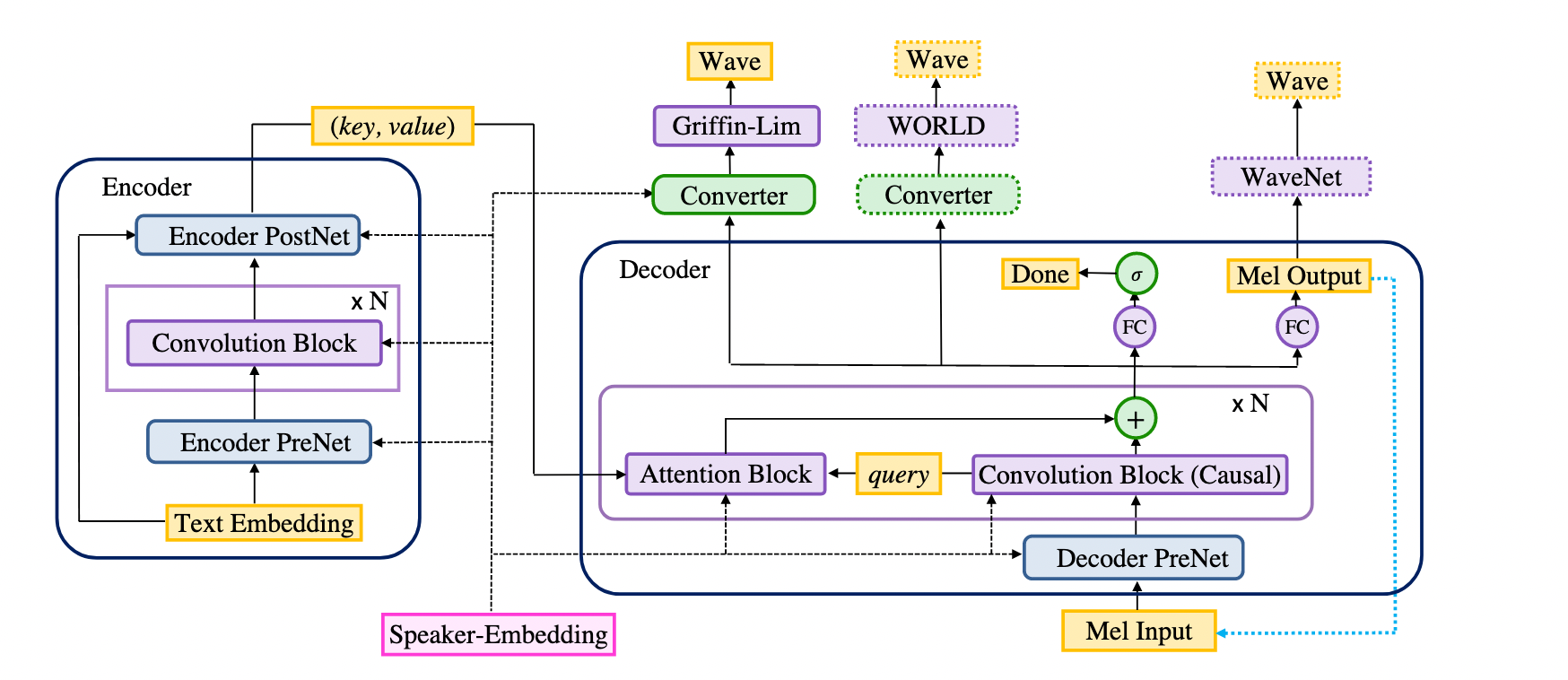|
|
||
|---|---|---|
| .. | ||
| images | ||
| README.md | ||
| data.py | ||
| ljspeech.yaml | ||
| sentences.txt | ||
| synthesis.py | ||
| train.py | ||
| utils.py | ||
README.md
Deepvoice 3
Paddle implementation of deepvoice 3 in dynamic graph, a convolutional network based text-to-speech synthesis model. The implementation is based on Deep Voice 3: Scaling Text-to-Speech with Convolutional Sequence Learning.
We implement Deepvoice 3 in paddle fluid with dynamic graph, which is convenient for flexible network architectures.
Dataset
We experiment with the LJSpeech dataset. Download and unzip LJSpeech.
wget https://data.keithito.com/data/speech/LJSpeech-1.1.tar.bz2
tar xjvf LJSpeech-1.1.tar.bz2
Model Architecture
The model consists of an encoder, a decoder and a converter (and a speaker embedding for multispeaker models). The encoder, together with the decoder forms the seq2seq part of the model, and the converter forms the postnet part.
Project Structure
├── data.py data_processing
├── ljspeech.yaml (example) configuration file
├── sentences.txt sample sentences
├── synthesis.py script to synthesize waveform from text
├── train.py script to train a model
└── utils.py utility functions
Train
Train the model using train.py, follow the usage displayed by python train.py --help.
usage: train.py [-h] [-c CONFIG] [-s DATA] [-r RESUME] [-o OUTPUT] [-g DEVICE]
Train a deepvoice 3 model with LJSpeech dataset.
optional arguments:
-h, --help show this help message and exit
-c CONFIG, --config CONFIG
experimrnt config
-s DATA, --data DATA The path of the LJSpeech dataset.
-r RESUME, --resume RESUME
checkpoint to load
-o OUTPUT, --output OUTPUT
The directory to save result.
-g DEVICE, --device DEVICE
device to use
--configis the configuration file to use. The providedljspeech.yamlcan be used directly. And you can change some values in the configuration file and train the model with a different config.--datais the path of the LJSpeech dataset, the extracted folder from the downloaded archive (the folder which contains metadata.txt).--resumeis the path of the checkpoint. If it is provided, the model would load the checkpoint before trainig.--outputis the directory to save results, all result are saved in this directory. The structure of the output directory is shown below.
├── checkpoints # checkpoint
├── log # tensorboard log
└── states # train and evaluation results
├── alignments # attention
├── lin_spec # linear spectrogram
├── mel_spec # mel spectrogram
└── waveform # waveform (.wav files)
--deviceis the device (gpu id) to use for training.-1means CPU.
example script:
python train.py --config=./ljspeech.yaml --data=./LJSpeech-1.1/ --output=experiment --device=0
You can monitor training log via tensorboard, using the script below.
cd experiment/log
tensorboard --logdir=.
Synthesis
usage: synthesis.py [-h] [-c CONFIG] [-g DEVICE] checkpoint text output_path
Synthsize waveform with a checkpoint.
positional arguments:
checkpoint checkpoint to load.
text text file to synthesize
output_path path to save results
optional arguments:
-h, --help show this help message and exit
-c CONFIG, --config CONFIG
experiment config.
-g DEVICE, --device DEVICE
device to use
--configis the configuration file to use. You should use the same configuration with which you train you model.checkpointis the checkpoint to load.textis the text file to synthesize.output_pathis the directory to save results. The output path contains the generated audio files (*.wav) and attention plots (*.png) for each sentence.--deviceis the device (gpu id) to use for training.-1means CPU.
example script:
python synthesis.py --config=./ljspeech.yaml --device=0 experiment/checkpoints/model_step_005000000 sentences.txt generated
